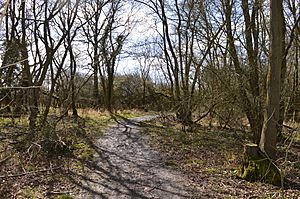Rushbeds Wood facts for kids
| Site of Special Scientific Interest | |
 |
|
| Area of Search | Buckinghamshire |
|---|---|
| Interest | Biological |
| Area | 80.2 hectares |
| Notification | 1982 |
| Location map | Magic Map |
Rushbeds Wood is a special nature reserve located near Wotton Underwood in Buckinghamshire, England. It covers about 56 hectares, which is like 140 football fields! This amazing place is looked after by the Berkshire, Buckinghamshire and Oxfordshire Wildlife Trust (BBOWT).
This reserve is a small part of an ancient forest called Bernwood Forest. It's also part of a bigger protected area known as Rushbeds Wood and Railway Cutting. This larger area is 80.2 hectares and is a "Biological Site of Special Scientific Interest" (SSSI). This means it's a very important place for plants and animals. The SSSI also includes a section of the Chiltern Main Line railway cutting, which runs along one side of the BBOWT reserve.
Contents
Discover Rushbeds Wood
Rushbeds Wood is an ancient woodland, meaning trees have been growing here for hundreds of years. The ground is made of heavy clay, which often gets very wet. This creates a unique environment for many different kinds of wildlife.
Amazing Animals and Plants
The wildlife at Rushbeds Wood is truly special! Experts from Natural England say the insects here are "exceptional." This means you can find many rare and interesting creatures.
Butterflies and Insects
Over thirty different types of butterflies live in Rushbeds Wood. Some of these are very rare, like the black hairstreak butterfly. You might also spot the scarce wood white and the beautiful purple emperor butterflies. These insects love the special plants and trees found in the wood.
Trees and Plants
The main trees in the woodland are wet ash and maple. You can also find elm and hornbeam trees. The plants growing under the trees, called the "understorey," show that this forest has been here for a very long time. Examples include Poa nemoralis and wood millet. The railway cutting area is mostly covered by a grass called upright brome.
Newts and Other Wildlife
Rushbeds Wood is also home to many common birds that build their nests here. In the ponds and ditches, you can find smooth newts and the larger, more protected great crested newts. These amphibians need clean water to live and reproduce.
Exploring the Reserve
If you want to visit Rushbeds Wood, you can get there by using a railway bridge. This bridge is located at the eastern corner of the site, making it easy to access this wonderful nature reserve. It's a great place to explore and learn about nature!

